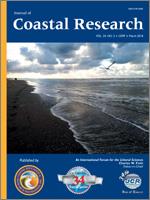Beach near the fisherman’s village of Katwijk, North Sea coast, The Netherlands
Using sediment from the bottom of the North Sea about 10-15 kmoffshore, this segment of the coast was nourished from 2013-2014. The fore dunes, beach, and nearshore area were reinforced as part of a coastal defense strategyto meet the newest national safety standards. After the nourishment was completed, the village of Katwijk and its low-lying hinterland are now better protectedagainst storm surge, sea-level rise, and other suspected impacts of climate change.
Average grain size of the nourished beach sand was measured to be about 300 μ. With a very low slope of approximately 10-15 degrees, this is a good example of a dissipative beach, where most of the wave energy is released through the process of wave breaking. Most prominent amongst the seashells in the foreground are the slim and long Ensis ensis, a common species in the North Sea waters. Also known as the sword razor or razor clam, E. ensis is a marine bivalve mollusc in the family Pharidae. It lives buried in the sand and can be found along the coasts of northwest Europe. (Photograph taken November 2017 by Frank van der Meulen, UNESCO IHE-Delft Institute for Water Education and Deltares, Delft, The Netherlands.)






